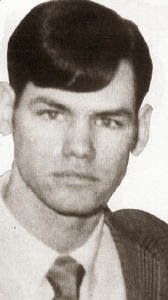Compiling a criminal profile after an offender has been captured is like forecasting yesterday's weather tomorrow. It takes little skill and runs counter to the purpose of profiling which is the apprehension of a prime suspect. Still, by reversing the process, I hope to develop a convincing profile of serial killer John Norman Collins (JNC).
JNC was charged and convicted of the sex slaying of Karen Sue Beineman in January of 1970. Karen was a freshman at Eastern Michigan University in July of 1969 when she willingly took a motorcycle ride from a handsome stranger who seemed harmless enough. She was never seen alive again.
Convicted of Karen's murder, JNC was believed by the court of public opinion to be responsible for the murders of at least six other women, though he was never formally charged with any of them. Washtenaw County Prosecutor William Delhey held the other cases in abeyance against the day that JNC would try to maneuver his way out of prison. He did not want to take a chance that Collins would ever get released without serving his full life sentence.
Because Collins was charged and convicted of only one murder, he is not officially considered a serial killer in accordance with FBI guidelines. His case has largely escaped public notice outside of Michigan and fallen into obscurity. That does not change the reality that he murdered more than one woman in the Ypsilanti/Ann Arbor area.
In addition to the Washtenaw County murders, JNC was indicted by a Monterey, California grand jury for the murder of seventeen year old Milwaukie, Oregon resident Roxie Ann Phillips. This murder case had hard physical evidence to link Collins to the victim. It was the strongest case against Collins, but Michigan Governor William Milliken denied California Governor Ronald Reagan his extradition request and California dropped the case.
***
Of the four FBI Behavioral Science Unit classifications for serial murderers, the Anger-Retaliatory Rape/Murderer and the Anger-Excitation Rape/Murderer classifications provide the most revealing profiling characteristics relevant to JNC. Each will be handled separately. Serial killers who represent in more than one category are called "mixed." John Norman Collins is one of those.
Anger-Retaliatory Rape/Murderer profile traits:
- Violent sexual assault with elements of "overkill." (All seven victims.)
- The fatal hostility may be directed at a mother, wife, or some dominant female who has belittled, humiliated, or rejected the subject. (JNC may have had repressed anger towards his domineering mother, or he felt anger when he was rejected by his high school sweetheart. It was recently learned that Collins' first intimate girlfriend at Eastern Michigan University turned up pregnant by another guy, and she dropped him.)
- A substitute victim is chosen who usually comes from the general area where the aggressor lives or works. (Four of the seven murdered young women lived within blocks of JNC.)
- The substitute victim is chosen while the murderer is conducting his daily routine, as when cruising his neighborhood or a public place, the aggressor may find a potential victim who reminds him of his mother or girlfriend. (Five of the seven victims were local.)
- The scapegoating retaliation does not eliminate the direct source of hate, so it needs to be episodically repeated. (Six of the seven victims.)
- Often uses a ruse to get the victim inside an enclosed place. Once inside, the victim is isolated and the killer confronts her. (The Karen Sue Beineman murder.)
- Beating around the face and mouth in response to the victim's rejection. As the assault becomes more combative, weapons of opportunity are used to brutalize the body. (All of the seven murders.)
- The body is often placed in a submissive position. (Three of the seven victims.)
- The crime scene tends to be unorganized following the aggressor's intense anger venting. (Three of seven murders.)
- The perpetrator often takes a small trinket or souvenir. (At least five of the seven but thought to be more.)
- When the sexual assault and murder is deemed a success, the perpetrator walks away feeling cleansed and refreshed. He has transferred the blame for the murder onto the victim, and he will not experience any sense of guilt or wrongdoing. (Over the forty-seven years since these events took place, JNC has yet to show any feelings of remorse for any of the victims or their families.)
Anger-Excitation Rape/Murderer profile traits:
- The sexual assault and homicide are designed to inflict pain and terror on the victim for psychological gratification. (At least six of the seven known murders.)
- Unlike other types of murderers, the luxury of sadism is found in the process of killing, not the death. Prolonged torture satisfies a lust for power and control. (At least five of the seven murders.)
- The homicide pattern is characterized by a prolonged, bizarre, ritualistic assault on the victim. (At least four of the seven murders.)
- The killer may be attracted to victims who meet certain criteria. (JNC's victims were brunette with shoulder length hair, they were small of stature, all but one had pierced ears, most lived near him, they were all young - thirteen to twenty-three years old, and all students but one.)
- When encountering a victim, these organized offenders can invoke a disarmingly charming manner that dispels the immediate fears of the victim. (Most if not all of Collins' victims appeared to go willingly with him.)
- The perpetrator uses a con or a ruse to dupe the victim from the time of contact until the victim is isolated. (The Joan Schell and Karen Sue Beineman murders for certain, the others likely.)
- Bondage and domination play a significant role in the killing process. (Four of the six murders.)
- The body may be left in a bizarre state of undress after possibly cutting the clothing off the victim. (Four of the seven victims.)
- Takes clothing items as souvenirs. (One souvenir box was destroyed by JNC and one was found under his bed. The Michigan State Police have these items in evidence boxes.)
- This type of serial killer leaves few if any signs or clues at the crime scene. (It was the fourth murder victim before a crime scene was found.)
- The murderer often moves the dead body to a different location from the crime scene and dumps it in a familiar location within his comfort zone to conceal or reveal his work. (All but one of the bodies was dumped within a ten mile radius in the sparsely populated farm country of Washtenaw County.)
- To avoid detection, this organized offender tends to commit his offenses distant from his usual activities. (JNC chose his victims from people not in his circle of known acquaintances for five of the seven murders.)
- For added stimulation, the murderer may attempt to interject himself into the criminal investigation. (JNC was known to have breakfast and/or lunch at the Bomber restaurant in Ypsilanti across the street from the Michigan State Police Post. Because he was the clean cut nephew of State Trooper David Leik, Collins traded on his uncle's name and often sat in with the local police and listened to their conversations about local police matters.)
- The subject derives great satisfaction by avoiding and taunting police creating a phantom scenario where the police are publicly criticized by the press and the public. (Leaving five of the seven bodies where they could easily be found, and dumping Karen Sue Beineman's body less than a mile from police Task Force headquarters were defiant acts.)
- In his daily habits, he is often compulsive and structurally organized. Educationally, he may have two years of college and/or have graduated. (JNC was about to begin his last year of college to earn a teaching degree.)
- These murderers can successfully segment their criminal interest into a private world of protected ritualism. (Collins still publicly denies killing anyone while smugly guarding his closely protected secrets.)
- The killer's souvenirs are often contained in a private chamber of horrors. This specialty place may be a dark closet, room, basement, or a hole in the ground. He may also use an abandoned barn, cabin, or garage. (It is known that JNC collected crime scene souvenirs in a BOLD detergent box that he disposed of, and he kept another box under his bed which Michigan State Police have in their custody.)
- Generally, the timing between murders lessens with experience. The anger-excitation rape/murderer is a predatory jackal who refines his skills at hunting and learns from his mistakes. When the satisfaction from the killing becomes brief and situational, the killing rate increases. (JNC's murder chart indicates this phenomenon which statisticians call The Devil's Staircase.)
Without a hardcore confession from John Norman Collins himself, the full truth of these matters will never be known. With JNC securely locked away, it is unlikely that he will ever be charged with any of the other six murders his name is associated with. But once what is known about these other cases is revealed, the court of public opinion will have little trouble deciding on Collins' guilt or innocence in the murders he was never charged with.
If you missed this four part series on profiling serial killers, here is the link to part one. http://fornology.blogspot.com/2014/05/the-fbis-violent-criminal-apprehension.html
***








